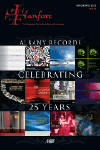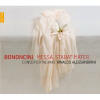Texte paru dans: / Appeared in:

Fanfare Magazine: 36:4 (03-04/2013)
Pour
s'abonner / Subscription information
Les abonnés à Fanfare Magazine ont accès aux archives du
magazine sur internet.
Subscribers to Fanfare Magazine have access to the archives of the magazine
on the net.
Naïve
OP30537

0709861305377 (ID247)
Consultez toutes les évaluations recensées pour ce cd
~~~~ Reach all the evaluations located for this CD
When I received this disc, I anticipated listening to sacred music by the rival of George Frederick Handel, Giovanni Battista Bononcini, which has been little recorded save for an early oratorio. Upon opening it, however, I found the music to be by his brother, Antonio Maria Bononcini (1677-1726). Although both came from a musical dynasty, Giovanni achieved international recognition, primarily for his operas, while his younger brother had a solid and rather mundane career as a court composer. That is not to say that he did not have moments of importance. He was well known in Italy as a church composer in both Bologna and Rome before traveling to Vienna in 1700 to join his brother as cellist in the court orchestra. By 1705 Giovanni had left and Antonio was appointed Kapellmeister, a post he held for less than 10 years. By 1713 he had returned to Lombardy, and in 1721 was finally appointed as maestro di cappella to the Este court in Modena, his home base during the post-Vienna years. As a composer, he achieved far less fame for his operas than his brother, composing the bulk of them only later in life, but nonetheless he was considered a figure of note in the Italian musical world of the late Baroque.
As noted, he seemed to have preferred to compose music for the church, although he also gained some fame for his vocal cantatas, many of which compete with his contemporary Alessandro Scarlatti from a musical standpoint. To date, he has been represented on disc with these and other chamber works, including a sampling this year released on Thorofon by La Ninfea, a group of cantatas on Arcana in 2004, and one of his many oratorios, La decollazione di San Giovanni Battista on Tactus back in 1999. His main claim to fame, however, is his Stabat Mater, of which this recording is the third. It first appeared with the Camerata Liguria on Bongiovanni in 1994, and the Collegio di Musica Sacra released their version on Dux a few years later. I found the Bongiovanni fairly unexciting, and I am not familiar with the Collegio’s version, so this particular issue piqued my interest.
The Mass is of the cantata variety, wherein each of the movements is subdivided, either into separate pieces (Kyrie, Gloria, Credo) or multiple tempos (Sanctus, Benedictus, Agnus Dei). The conductor states in his liner notes that it “radiates a splendor of inspiration and a profundity comparable to that of the greatest contrapuntists, from Bach downwards.” That is a tall order, though I am confused what that last statement means; it is really a mistranslation of what in French reads “à partir de Bach,” or “Bach and afterwards.” So, Bononcini is to be compared with the intricate and complex contrapuntal monuments of Johann Sebastian Bach. Unfortunately, I find that this comparison falls far short. Bononcini is good at what he does, but his fugues and imitation are not up to that level, in my opinion. This does not, however, make it a second-rate work. Though the individual movements are by and large relatively short, the composer endows them with some surprisingly delightful characteristics, not all of which are fugal. The “Christe eleison,” sung with a nice tonal blend by sopranos Raffaella Milanesi and Sara Mingardo, as well as bass Salvo Vitale, is an elegant trio that flows effortlessly and lyrically, with only the occasional punctuation of dissonant harmonies in some nice suspensions. These are also evident in the twisting and turning lines of the Gloria, which contain some of the best and most arduous choral writing next to Vivaldi or Handel. The “Gratias agimus tibi” has a fluid cantus firmus above a ground bass that ranges from a walking line to a chaconne bass. The “Qui tollis” is almost ethereal in its unfolding homophony, a moment of magical majesty. The “Cum sancto spiritu” is a fugue, but where the subject and countersubject often collide before devolving into episodic suspensions. This is quite a unique approach to counterpoint, sounding at moments for all the world more advanced than the time it was written. The Sanctus is hardly solemn, with a rapidly moving bass line above which each lyrical vocal line enters and weaves in and out of each other.
There is of course much more to the Mass, but one should not neglect the Stabat Mater, given that it is a carefully constructed and poignant work. The melting suspensions of the “Quis est homo” are as flowing and emotional as Giovanni Pergolesi; the duet between the violin and alto in the “Eia, mater” has a tortuous line that is underscored by the dotted rhythms of the accompaniment. The slowly evolving homophonic chords of the “Virgo virginum” are nicely transparent, while the “Fac me cruce” is positively Vivaldian in its interplay between the bass voice and strings.
One could go
on, but suffice it to say that this recording of the Stabat Mater, at least,
supersedes those that have come before. It is a marvelous work, worthy of
standing alongside Pergolesi. As for the Mass, it too is a fine composition,
though hardly epoch defining. It does, however, complement the Stabat Mater
quite well. As for the performance, Alessandrini provides a solid set of
tempos and has a good sense of phrasing. The solo voices are uniformly
excellent, with good intonation and fine interpretive skills. My only
quibble is with the sound. Occasionally the plucked instruments, presumably
reinforced by the doubling of the theorbo, produce an almost overwhelming
twang in the lower registers. I also find the violins sometimes a bit
submerged in the chorus during the Mass. This, however, should not cause any
real alarm, for the recording is to be highly recommended for both its
performance and the music that it presents.
Fermer la fenêtre/Close window
Cliquez l'un ou l'autre
bouton pour découvrir bien d'autres critiques de CD
Click either button for many other reviews


